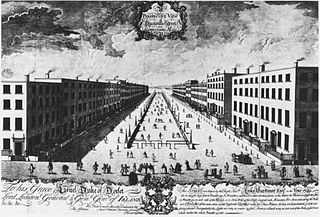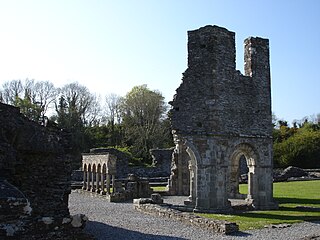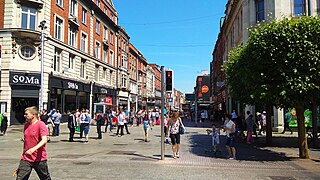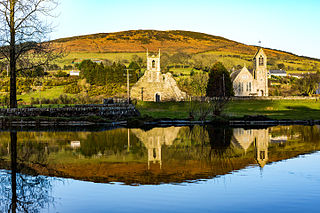
The Northside in an informal but commonly used term to describe the part of the city of Dublin that lies to the north of the River Liffey, and extending into part of North County Dublin. The part outside the city is within the county of Fingal, a local government area established in 1994. While it is sometimes regarded as less wealthy than the city's Southside, the Northside was originally the home of the city's upper classes and the more privileged of the two. Today, some of the wealthiest areas in Ireland, such as Malahide, Howth, Clontarf, and Castleknock, lie north of the river.

The Wide Streets Commission was established by an Act of Parliament in 1758, at the request of Dublin Corporation, as a body to govern standards on the layout of streets, bridges, buildings and other architectural considerations in Dublin. The commission was abolished by the Dublin Improvement Act of 1849, with the final meeting of the Commission taking place on 2 January 1851.

Kilmacduagh Monastery is a ruined abbey near the town of Gort in County Galway, Ireland. It was the birthplace of the Diocese of Kilmacduagh. It was reportedly founded by Saint Colman, son of Duagh in the 7th century, on land given him by his cousin King Guaire Aidne mac Colmáin of Connacht.

Mellifont Abbey, was a Cistercian abbey located close to Drogheda in County Louth, Ireland. It was the first abbey of the order to be built in Ireland. In 1152, it hosted the Synod of Kells-Mellifont. After its dissolution in 1539, the abbey became a private manor house. This saw the signing of the Treaty of Mellifont in 1603 and served as William of Orange's headquarters in 1690 during the Battle of the Boyne.

Mornington is a coastal village on the estuary of the River Boyne in County Meath, Ireland approximately 5 km downriver from the centre of Drogheda. Together with the neighbouring villages of Laytown, Bettystown and Donacarney, it comprises the urban area of Laytown–Bettystown–Mornington–Donacarney with a combined population of 15,642 at the 2022 census.

Sir William Robinson PC(I) was a British architect, military engineer and politician. He held several posts in the Dublin Castle administration, including as Surveyor General of Ireland from 1671 until 1700. He was an influential figure in the development of classical architecture in Ireland, designing many buildings in the English Baroque-style, particularly in Dublin.

The Liberty of Thomas Court and Donore was one of several manors, or liberties, that existed in County Dublin, Ireland since the arrival of the Anglo-Normans in the 12th century. They were adjacent to Dublin city, and later entirely surrounded by it, but still preserving their own separate jurisdiction.

Abbey Presbyterian Church is a church located at Parnell Square, Dublin. Designed by architect Andrew Heiton of Perth, Scotland, it is a decorated Gothic building, with a spire 180 feet (54.9 m) high. The church was erected in 1864 with funding from Alexander Findlater (1797–1873), a Dublin merchant and philanthropist, and is known colloquially as "Findlater's church", and it is referred to in two of James Joyce's novels as Findlater's Church.
Charles Moore, 2nd Viscount Moore of Drogheda (1603-1643) was an Irish aristocrat noted for his leadership of Irish Royalist forces in northern Leinster during the early stages of the Irish Confederate Wars.

North Earl Street is a short stretch of city-centre street located on Dublin's Northside and formerly a major shopping area. It runs from Marlborough Street in the west to O'Connell Street beside the Spire.

Baltinglass Abbey is a ruined medieval Cistercian abbey in Baltinglass, County Wicklow, Ireland. Founded by Diarmait Mac Murchada in 1148, the abbey was suppressed in 1536. It is today a National Monument.

Humphrey Jervis (1630–1707) was one of the first notable private developers in the history of Dublin.

The Unitarian Church in Ireland presently consists of two Congregations, Dublin and Cork, part of the Synod of Munster, in the Republic of Ireland, which has itself been part of the Non-Subscribing Presbyterian Church of Ireland since 1935. Some congregations remain closely associated with the General Assembly of Unitarian and Free Christian Churches. These churches would abide by the traditional Unitarian principles of Freedom, Reason, and Tolerance.

Killaghaduff is a townland in the civil parish of Kinawley, barony of Tullyhaw, County Cavan, Ireland.

Capel Street is a predominantly commercial street in Dublin, Ireland, laid out in the 17th century by Humphrey Jervis.

Cathedral Street is a street in central Dublin, Ireland, formerly known as Elephant Lane and Tyrone Place.



















